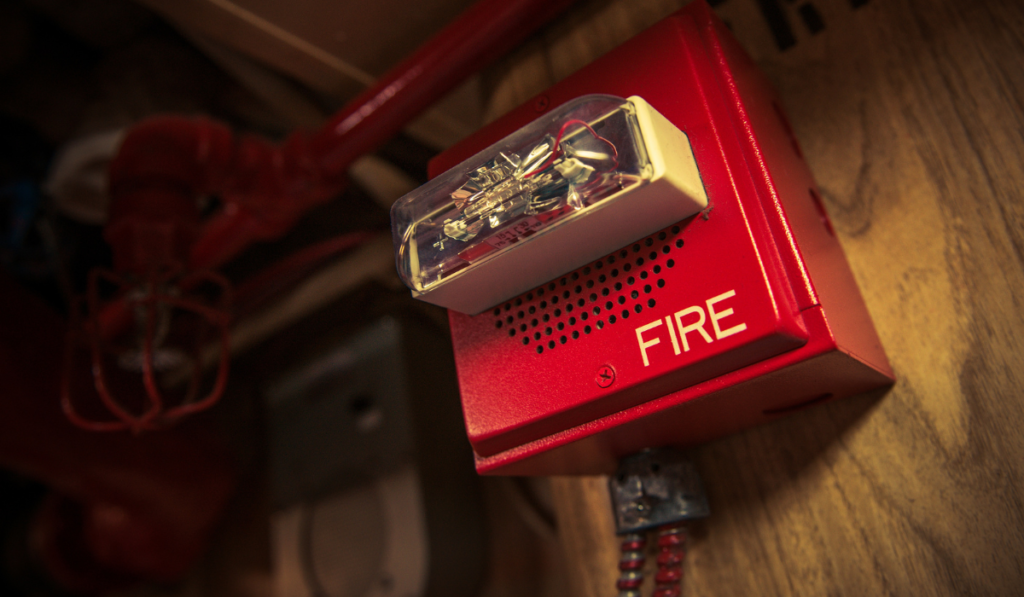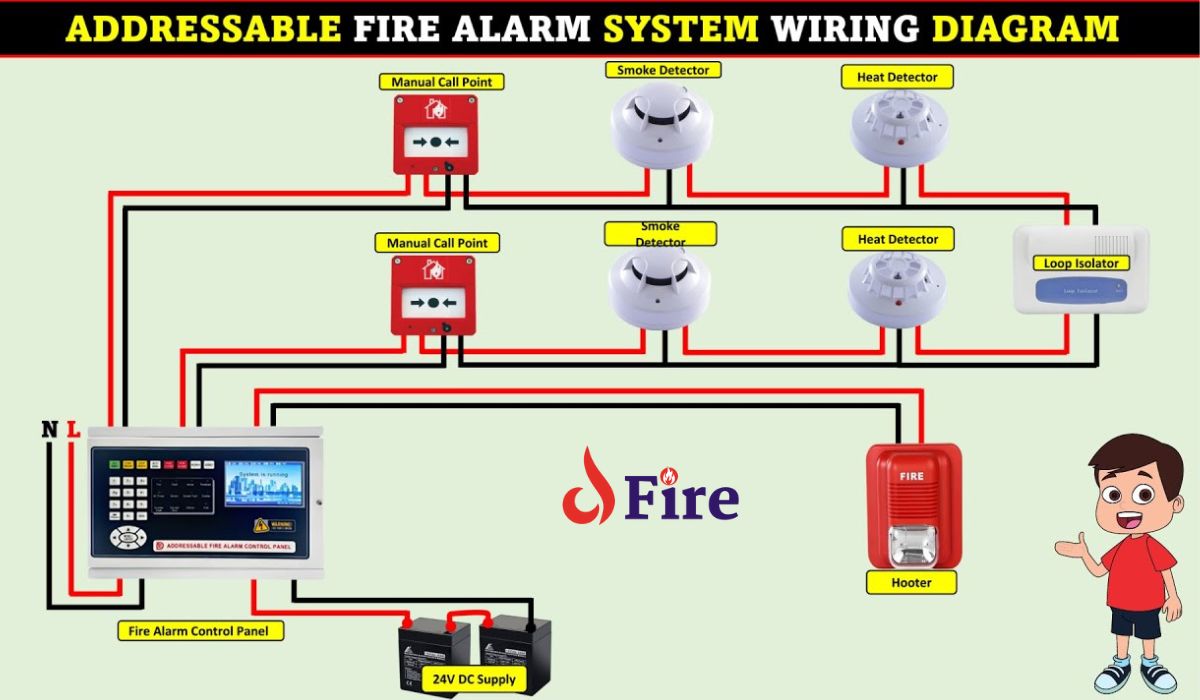An Addressable Fire Detection System pinpoints the exact location of a fire within a building. It assigns a unique address to each device, allowing for precise identification and faster response.
Addressable fire detection systems are a sophisticated leap in ensuring safety and security in commercial and residential spaces. These systems interconnect a network of smoke detectors, heat detectors, and manual call points that report back to a central control panel.
Each connected device has a specific address, providing the exact origin of fire alarms. This pinpoint accuracy is crucial for large buildings, where rapid identification of a fire’s location can save lives and property. Maintenance also becomes more efficient, as the system can identify faults or malfunctions in individual devices. By offering real-time updates and detailed monitoring, addressable fire detection systems are an essential component in modern fire safety strategies.

The Critical Role Of Fire Detection Systems
An effective fire detection system serves as an early warning mechanism. It protects lives and property. It senses heat, smoke, or flames. It alerts occupants to evacuate swiftly. Quick detection is key to reducing fire damage. It gives fire services more time to respond.
Early Warning Signals Save Lives
Fire detection systems provide immediate alerts. These notifications come before a fire spreads. They alert through sirens, lights, or messages. This rapid alert is crucial. It allows people to leave the building. Every second counts during a fire.
- Quick detection minimizes injury risk.
- Early evacuation prevents loss of life.
- Systems are designed to be user-friendly and reliable.
Evolution Of Fire Safety Technology
Fire safety technology has evolved over years. Older systems used basic smoke detectors. Modern systems use advanced sensors. They detect various fire indications. The technology has improved. It is now more precise and dependable.
| Year | Advance |
|---|---|
| Early Systems | Basic Smoke Detectors |
| Modern Systems | Multi-criteria Detectors |
Today’s systems offer remote monitoring. They integrate with building management solutions. Consistent upgrades ensure systems remain effective. Fire safety technologies aim to stay ahead of risks. They provide greater protection for all.
Unveiling Addressable Fire Detection Systems
When safety is on the line, addressable fire detection systems stand out. These systems pinpoint the exact location of a fire, providing critical information swiftly. This results in faster response times, potentially saving both lives and property. Let’s delve into the mechanics and benefits of addressable systems.
How Addressable Systems Work
An addressable fire detection system uses a digital approach. Each detector has a unique address. When a fire occurs, the system identifies the specific device triggered. This information shows on a central control panel.
- Two-way communication: The panel talks to each detector. It checks their status and controls settings.
- Unique identification: Every sensor communicates its precise location.
- System integrity: The system checks wires and detectors for faults.
- Evacuation guidance: Alert zones guide safe evacuation routes.
Distinct Features And Advantages
Addressable systems bring unique strengths to the table.
| Feature | Advantage |
|---|---|
| Precise location detection | Quick identification of fire source. |
| Reduced false alarms | Smart sensors differentiate smoke from steam. |
| Easy to expand | Add more detectors without new wires. |
| Efficient monitoring | System checks itself for faults. |
These systems aren’t just smart. They’re designed to be user-friendly, with clear displays and intuitive controls. In an emergency, this can mean the difference between chaos and a coordinated response. An addressable system offers unparalleled protection for your premises.
Comparing Addressable And Conventional Systems
Fire safety is a major concern for all property owners. Choosing the right detection system is crucial. Addressable fire detection systems and conventional ones have their own advantages. Knowing the differences helps in making an informed decision.
Key Differences And Similarities
Addressable and conventional fire systems have unique features. Both aim to protect people and property from fire. Still, the way they operate varies.
| Feature | Addressable System | Conventional System |
|---|---|---|
| Identification | Precise location | General zone |
| Wiring | Loop | Radial |
| Complexity | High | Low |
| Cost | More expensive | Less expensive |
| Scalability | Flexible | Limited |
- Both can detect fire.
- They alert occupants.
- Regular maintenance is key for both.
Making The Right Choice For Your Premises
Selecting the right system depends on multiple factors:
- Size of the property
- Complexity of the building
- Regulatory requirements
- Budget
Addressable systems fit large buildings with many rooms. They give detailed information in an emergency. Conventional systems work well in smaller spaces. They cost less and are simpler.
Each premises needs a tailored approach. Always engage professionals for the best advice. They assess the specific needs. They ensure the chosen system meets all requirements. Safety and compliance are the priority. Make the investment that secures lives and property.
Technological Innovations In Fire Detection
Fire safety technology is advancing at an incredible pace. State-of-the-art addressable fire detection systems are at the forefront of protecting lives and properties. These systems don’t just sound an alarm; they discern locations of fires with precision, facilitate rapid response, and are becoming an integral part of modern fire safety protocols. Let’s explore some of these cutting-edge innovations shaping the future of fire safety.
Integration With Smart Buildings
Smart buildings harness technology to boost safety and efficiency. Modern fire detection systems integrate seamlessly into these intelligent infrastructures. They work hand-in-hand with other automated systems – like HVAC, security, and lighting – to create a harmonious safety network. Here’s how they enhance fire safety:
- Automatic adjustments of building systems to contain fire spread.
- Precise location tracking of fire incidents for faster emergency response.
- Real-time alerts and updates sent directly to occupants and first responders.
The Future Of Fire Safety
The frontier of fire detection is exciting and holds the promise of even greater safety features. Innovations such as AI-driven predictive analytics could revolutionize how fires are prevented. Instead of reacting to fires, future systems will anticipate and mitigate risks. Here’s a glimpse into what’s coming:
| Predictive Analysis | Connected Devices | Autonomous Response |
|---|---|---|
| Systems learn fire patterns to foresee risks. | Detectors communicate for a coordinated effort. | Robots and drones could assist firefighting efforts. |
Investment in these state-of-the-art technologies is crucial. They not only ensure safety but also define the innovative paths of fire detection and prevention for years to come.
Installation And Maintenance Considerations
Addressable Fire Detection Systems are critical for ensuring the safety of both people and property. The effectiveness of these systems hinges not only on proper installation but also on rigorous maintenance. Considering the complexity and importance of these tasks, here are some essential guidelines and practices to keep in mind.
Planning Your System Installation
A successful installation begins with detailed planning. Key steps include:
- Assess the building layout to determine optimal detector locations.
- Ensure compliance with local fire safety codes.
- Select high-quality equipment suitable for your specific needs.
Prioritize collaboration with certified professionals who specialize in fire detection systems.
| Installation Step | Details |
|---|---|
| Site Evaluation | Review the premises for environmental factors that impact system design. |
| System Design | Tailor the setup to the building’s size and complexity. |
| Equipment Selection | Choose devices with the latest technology for reliable performance. |
Ongoing Maintenance And Inspection Routines
To ensure your system’s reliability, regular maintenance is vital. Activities should include:
- Monthly visual inspections for signs of damage or obstruction.
- Annual professional assessments to certify functionality.
- Immediate repairs for faulty components detected during inspections.
Maintain a logbook documenting all maintenance actions for accountability and historical records.
Responding To Alarms: Best Practices For Addressable Systems
Responding promptly and effectively to fire alarms saves lives and property. Modern addressable fire detection systems provide advanced warning and pinpoint the location of potential threats. Adhering to best practices ensures rapid, organized responses during critical moments.
Identifying False Alarms From True Threats
Addressable systems offer advanced diagnostics for distinguishing false alarms from real dangers. They reduce disruption and anxiety caused by erroneous alerts. Personnel need training to interpret signals for swift, accurate assessments.
- Regular maintenance checks minimize false alarms.
- Effective drill protocols train staff in threat recognition.
Evacuation Strategies And Emergency Responses
Executing a well-planned evacuation is crucial in an emergency. Addressable systems map alarm locations, guiding tailored evacuations. This ensures safe, orderly exits from the premises.
| Step | Action |
|---|---|
| 1 | Initiate the alarm response procedure. |
| 2 | Guide personnel to designated exits. |
| 3 | Account for all individuals in assembly areas. |
Key roles assigned to staff include fire wardens and first responders. They help execute evacuation plans effectively.
- Fire wardens verify areas are clear.
- First responders assist as necessary.
Regulatory Standards And Compliance
Keeping up with the necessary regulatory standards and compliance is paramount for any addressable fire detection system. Laws exist to protect lives and properties. Understanding and adhering to these regulations is key to any system’s design and implementation. Below, we delve into the specifics of these regulatory frameworks.
National And International Fire Safety Codes
Fire safety is a critical concern. It demands strict adherence to both national and international codes. These codes encompass comprehensive rules for design, installation, and maintenance.
- NFPA 72: The National Fire Alarm and Signaling Code, a standard for the installation of fire alarms.
- International Building Code (IBC): Offers guidelines for fire safety within buildings, influencing alarm system requirements.
- EN 54: European standard that outlines the specifics for fire detection and fire alarm systems in buildings.
These code parameters ensure that systems function effectively when an emergency strikes. Compliance is not merely advisable; it’s a legal must.
Ensuring Your System Meets Legal Requirements
Regular audits and reviews are crucial to stay compliant. It guarantees that fire detection systems meet current legal criteria. Compliance involves several steps:
- Consult with a certified fire safety engineer who understands the legal codes.
- Perform regular system inspections and maintenance to uphold functionality and compliance.
- Keep records of all system updates, tests, and official inspections.
This proactive approach ensures continual readiness. It minimizes legal risks and enhances safety for all occupants.
Case Studies: Addressable Systems In Action
Case Studies: Addressable Systems in Action explores real-world examples of the life-saving technology.
Addressable fire alarms provide specific location information, enabling quicker response times.
These stories reveal the effectiveness of addressable systems.
Success Stories From The Field
- At a high school, an addressable fire alarm detected smoke in a lab. Teachers evacuated promptly. No injuries occurred.
- A library’s system pinpointed a fire’s exact location. Firefighters extinguished the flames before they spread.
- In an office building, maintenance received alerts about a malfunctioning device. They fixed the issue before any fire started.
Lessons Learned From Past Incidents
- Regular maintenance is crucial. One incident showed system neglect can lead to sensor failures.
- Immediate action saves lives. A delayed reaction in a past case extended damage.
- Integration with other systems, like sprinklers, proves essential. This combined response often reduces harm.
Investing In Safety: The Financial Implications
Safety is paramount and an investable commodity, especially
when it concerns protecting life and property. An addressable fire detection
system represents a smart choice for any establishment, but with every smart
choice comes a cost. Understanding the financial implications
is pivotal before investing in such advanced safety measures.
Cost-benefit Analysis Of Addressable Systems
Addressable fire detection systems may have a higher upfront cost compared
to traditional systems, but undertaking a cost-benefit analysis
reveals long-term financial gains. These systems pinpoint fire locations instantly,
thereby reducing response times and potential damage.
- Decrease in fire-related damages and associated costs.
- Reduction in false alarm instances, cutting down on disruptions and fines.
- Maintenance occurs on a need-based manner, saving on regular check-up fees.
Long-term Savings And Insurance Impact
A smart investment in addressable fire detection systems not only ensures safety but
also transcends into long-term savings. These systems can lead to
lower insurance premiums due to their efficiency and reliability.
| Aspect | Impact |
|---|---|
| Advanced Detection | Minimized damage expenses |
| Insurance Incentives | Potential for reduced premiums |
| System Longevity | Extended life span with less need for replacement |
Further, the durability and scalability of these systems
mean they adapt to a business’s growth, eliminating the need for complete overhauls—a
massive plus for financial forecasting.

Credit: en.wikipedia.org
Conclusion: The Imperative Of Upgrading To Addressable Fire Detection
Conclusion: The Imperative of Upgrading to Addressable Fire Detection marks a crucial turning point in the discussion about fire safety. Traditional systems no longer suffice in the face of today’s safety demands. Advanced, addressable fire detection systems offer precise, fast, and reliable vigilance, which is necessary for the protection of lives and property. This transition is not just a technical upgrade; it’s a fundamental shift towards a safer future.
Elevating Safety In Commercial And Residential Buildings
Upgrading to an addressable system ensures immediate location identification during a fire emergency. These intelligent systems minimize false alarms and enhance response times. For both commercial and residential buildings, this means faster evacuation and quicker action to prevent fires from spreading. Enhanced safety features include:
- Individual device monitoring for pinpoint accuracy
- Real-time updates that facilitate rapid response
- Lower maintenance costs with easy trouble-shooting
Taking The Next Steps Towards Enhanced Fire Safety
Making the switch to an addressable fire detection system is a proactive step towards enhanced safety. Start by:
- Consulting a fire safety expert to assess current systems.
- Planning the transition to minimize disruption.
- Implementing the new system with certified technicians.
It’s time to prioritize safety upgrades. Addressable fire detection systems protect investments and, more importantly, save lives. Embrace the technology to create a safer environment for everyone.

Credit: www.nytimes.com
Frequently Asked Questions For Addressable Fire Detection System
What Is An Addressable Fire System?
An addressable fire system is a security mechanism that individually monitors and identifies the exact location of fire alarms within a building.
What Is Difference Between Addressable And Conventional Fire Alarm System?
Addressable fire alarm systems pinpoint exact alarm locations, whereas conventional systems indicate zones, not specific points. Addressable systems offer more precision and ease of identification in case of an emergency.
What Are The Disadvantages Of The Addressable Fire Alarm System?
Addressable fire alarm systems can be costlier than conventional ones, with higher initial setup and maintenance expenses. Their complexity requires professional installation and may complicate user operation. False alarms are possible if the system isn’t properly configured.
What Is The Difference Between Addressable And Intelligent Fire Alarm Systems?
Addressable fire alarm systems pinpoint the exact location of a triggered device, while intelligent systems analyze and assess environmental conditions to minimize false alarms.
Conclusion
Embracing an addressable fire detection system elevates safety standards to new heights. It ensures precise location tracking and swift emergency responses. With such a system, property and lives are guarded more effectively. Opt for this smart solution to enjoy peace of mind and enhanced fire protection.
Secure your premises now.

I’m Abdus Sobur, a highly skilled and professional Fire Safety Officer with a passion for safeguarding lives and property. Over the course of my career, I’ve conducted numerous successful fire safety audits, earning a reputation for excellence in ensuring public safety.
In addition to my role as a Fire Safety Officer, I’m also dedicated to raising awareness about the importance of fire safety. Through my blog, I share insights into the functions of different fire safety equipment, aiming to empower individuals with the knowledge they need to protect themselves and their communities.
I’m driven by a deep commitment to promoting fire safety awareness and preventing fire-related incidents.

